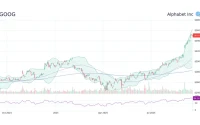HOOD, DUOL, QCOM, APP, SNAP: Decoding the Day's Trading Frenzy
The market had a decent Wednesday, with the Dow, S&P 500, and Nasdaq all showing gains. But the real action, as usual, was in individual stocks. Robinhood, Duolingo, Qualcomm, AppLovin, and Snap—all names that get the retail crowd buzzing. Let’s slice through the noise and see what the numbers really say.
Robinhood's Revenue Rocket
Robinhood (HOOD) saw a 4.15% jump, closing at $142.48, before dipping slightly in after-hours. The headline? A 100% year-over-year revenue surge in Q3, hitting $1.27 billion. Earnings per share also crushed expectations, coming in at 61 cents against an expected 48 cents. Transaction-based revenue nearly doubled, fueled by crypto, options, and equities trading. Net deposits hit a record $20 billion. Funded customers rose 10% to 26.8 million. The average revenue per user (ARPU) jumped 82% to $191. Those are some big numbers.
But here's where the analyst's skepticism kicks in. A 100% revenue jump is impressive, sure, but is it sustainable? How much of that was driven by meme-stock mania or a temporary crypto surge? And let's talk about that ARPU. An 82% jump is eye-catching, but what's the cost to acquire those users, and more importantly, to retain them? Robinhood's value is in the 4th percentile according to Benzinga’s Edge Stock Rankings. (That's not exactly confidence-inspiring.) Where does Robinhood see its growth coming from in the next 3-5 years, and how will they avoid another meme-stock fueled blowup?
Duolingo's Disconnect
Duolingo (DUOL) presents a more complex picture. The stock fell 0.77% during the day and then tanked nearly 20% in after-hours, despite reporting better-than-expected revenue ($271.7 million versus $260.33 million). Daily active users (DAUs) rose 36% to 50.2 million, and monthly active users (MAUs) climbed 20% to 135.3 million. The problem? Earnings per share apparently didn't meet estimates, and investors are concerned about slowing user growth.
Honestly, I’m not sure I buy the "slowing user growth" narrative as the sole reason for the after-hours plunge. A 20% increase in MAUs is still significant. (And this is the part of the report that I find genuinely puzzling.) The bigger question is monetization. How many of those DAUs and MAUs are actually paying subscribers? What's the conversion rate from free to paid, and is it improving or stagnating? And is Duolingo expanding into higher-value language services, or are they still primarily focused on basic vocabulary and grammar?
Qualcomm's Quiet Confidence
Qualcomm (QCOM) had a solid day, rising almost 4% to close at $179.72, after which it fell 2.6% in after-hours trading. Fourth-quarter revenue came in at $11.27 billion, up 10% year-over-year, beating estimates. Adjusted earnings per share were $3, also above expectations. The company has now delivered ten straight EPS beats and nine consecutive revenue beats. Qualcomm seems to be the mature, reliable player in this group.

But even here, a closer look is warranted. While QCT (Qualcomm CDMA Technologies) revenue rose 13%, QTL (Qualcomm Technology Licensing) revenue fell 7%. That’s a crucial distinction. Qualcomm's future hinges on its ability to innovate in chip design and maintain its dominance in the mobile space, not just collecting licensing fees on existing patents. What’s the roadmap for the next generation of mobile technology, and how is Qualcomm positioning itself against rivals like MediaTek?
AppLovin's Ad Ascent
AppLovin (APP) climbed 1.38% during regular trading and then shot up nearly 6.4% in extended trading. Third-quarter revenue hit $1.41 billion, beating estimates, with earnings of $2.45 per share also exceeding expectations. Revenue rose 68% year-over-year, and operating and free cash flow both reached $1.05 billion. The company is buying back stock. Everything looks rosy.
However, AppLovin operates in the volatile world of mobile advertising. The question is how sustainable is this growth? Mobile ad spending is notoriously cyclical and sensitive to economic conditions. What’s AppLovin’s strategy for diversifying its revenue streams and mitigating the risk of a downturn in the ad market?
Snap's Snapback (Attempted)
Snap (SNAP) declined 2.21% during the day but then jumped nearly 15% in after-hours trading. The company reported a smaller-than-expected loss (six cents per share versus an expected 12 cents) and revenue that beat estimates ($1.5 billion versus $1.49 billion). They also announced a $500 million stock buyback. The after-hours surge suggests investors are breathing a sigh of relief, but I'm not convinced.
Snap is still losing money, and its user growth is slowing. The social media landscape is fiercely competitive, and Snap faces intense pressure from TikTok, Instagram, and other platforms. A $500 million stock buyback is a nice gesture, but it doesn't address the underlying issues of profitability and user engagement. Snap needs to demonstrate a clear path to sustainable growth, and that's far from guaranteed. What new features are they developing to recapture user attention, and how are they planning to monetize those features effectively?
A Sugar Rush, Not Sustained Growth
The numbers paint a mixed picture. Some companies (Qualcomm, AppLovin) seem to be on solid footing, while others (Robinhood, Duolingo, Snap) face significant challenges. A few good quarters does not guarantee long-term success. Investors need to look beyond the headlines and dig into the underlying data to understand the true story.










